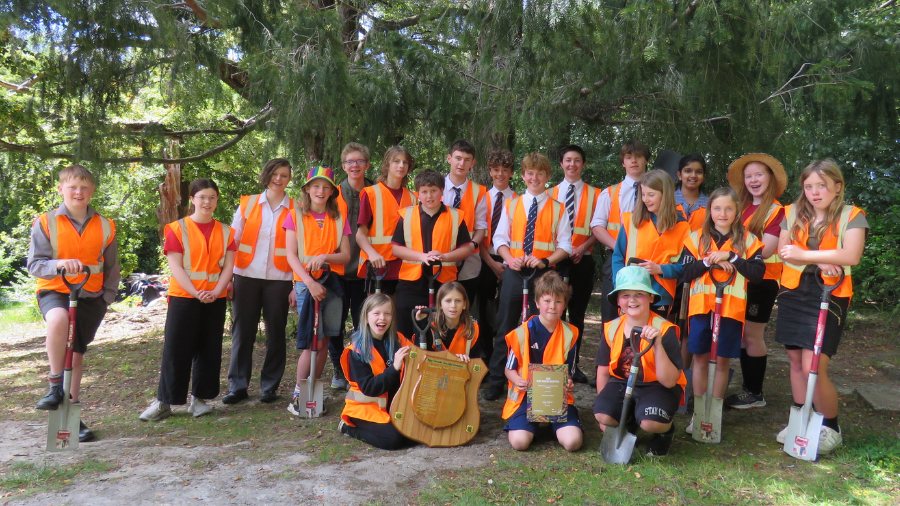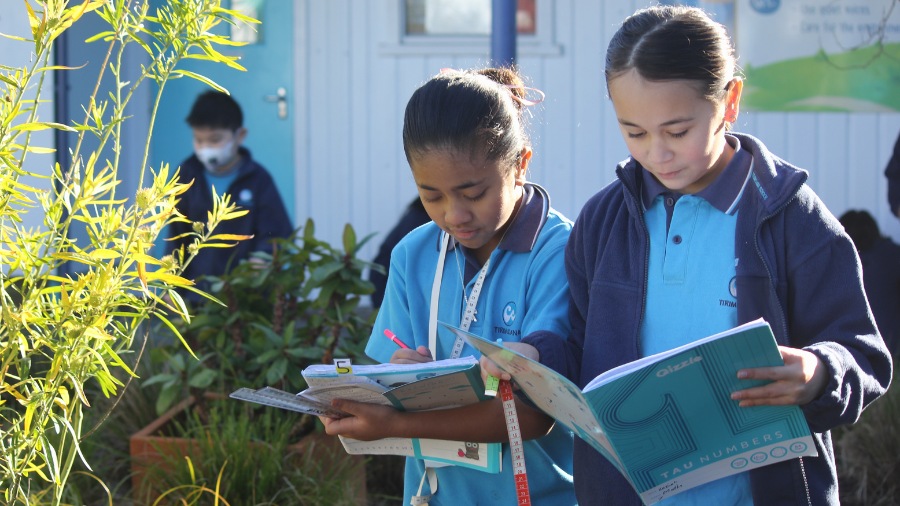Connecting with place supports meaningful relationships between learning, community and the environment.
The integration of Aotearoa NZ Histories into our curriculum, alongside the wider Social Sciences refresh and equal status for Mātauranga Māori, provides a chance to reflect on your personal knowledge and learn more about the places you live and work. This is an important professional learning priority and there are a range of resources available to help you on your journey, including some aimed specifically at tauiwi and tangata Tiriti, which we explore further below.
This Spotlight includes stories and resources to provide inspiration and support for kaiako and ākonga. This is just a starting point and there are many other resources available, including those specific to your local area. Building and maintaining reciprocal relationships with mana whenua, community groups and local organisations is a key part of this journey.
New Resources
We regularly update this Spotlight with new information and wanted to draw your attention to some new teaching resources that have been released in late 2024. Both of them provide frameworks to guide student inquiry into our connection with te taiao, local places and mātauranga Māori.

Earth Dreamers supports teachers and students to explore the complex global issue of the climate crisis within their local contexts in ways that foster joy and agency, curiosity, and hope. Focused around the Social Sciences curriculum, there are also links across many learning areas.
He taura taiaoe kore e motu - Exploring our relationships with nature is one of four inquiry areas in Earth Dreamers. Activities are designed to support teachers and ākonga to connect with mana whenua and their local community.
Ākonga explore ways in which mātauranga Māori may help cultivate connection, respect, and reciprocity with our natural world. - Earth Dreamers

Ko au te taiao is a learning resource from Te Papa that encourages teachers and learners to explore mātauranga Māori values, observe te taiao, and take action for a better world.
Ko au te taiao: recognising we are nature through mātauranga Māori and Te Papa’s Collections, is designed in two sections: Explore and Create.
Explore some of the traditional mātauranga that has developed from a living relationship with our environment. This section is focused on knowledge acquisition and linking to the rich collection in Te Papa Collections Online.
Create and grow your own relationship to te taiao. This section is focused on learner participation and action in response to the explore section.
What is Place-Based or Place-Responsive Learning?
Watch this video from the Māori History online portal. Professor Wally Penetito discusses the key elements of place-based learning and asks us to "challenge our taken-for-granted world". This resource also includes a list of professional learning conversations that could be used with your colleagues.
A Sense of Place is a teaching resource for Aotearoa NZ Histories in Years 1 - 3. It explores how the relationships of individuals, groups, and communities with the land, water, and resources are reflected in the names of places and in the stories we tell about them. This resource shows how five texts from the School Journal series can be used to support learning in the context of tūrangawaewae me te kaitiakitanga through stories, names, whakairo (carvings), and pepeha.
Pūtātara is a valuable and relevant resource for educators and students to explore concepts such as tūrangawaewae and kaitiakitanga. Explore the themes, questions and activities on the website and watch this webinar with educator Sarah Hopkinson and teachers from Fergusson Intermediate discussing how they have used Pūtātara to support their place-based curriculum.

Read this Enviroschools story exploring how their visionary processes can help consolidate the design of local curriculum. It includes useful links and ideas for teachers, along with a section of inspiring case studies from schools around the motu, including Learning Barefoot at Paekākāriki.
“It is through play and exploration that tamariki can truly experience and understand their place and each other."
- Julia Bevin, Principal at Paekākāriki School
Whangamata Kindergarten discuss how they have nurtured a sense of place in their tamariki in this Enviroschools story: A strong sense of place enables children to teach others.
Waimea College students have worked with local mentors, council and community groups to improve local wetland habitat for Moho pererū | Banded rail. Read more in this Education Gazette article: Kaitiakitanga in Waimea Inlet.
For Mana College, the catalyst for focusing and trialing place-based learning started with a re-think of their Year 9 camp, with support from Education Outdoors NZ through their Revisioning School Camps professional learning. You can listen to their story, in this interview facilitated by Sophie Watson from EONZ, with Robert Stratford and Jeff Chapman from Mana College.
Mātauranga Māori
Engage with Mana ōrite mo te mātauranga Māori | Equal status for mātauranga Māori content, which includes resources and webinars with a range of amazing speakers. Reflect on how this mahi overlaps with planning your local curriculum, engaging with the community and connecting with your environment.
Te Ahukaramū Charles Royal (in Webisode 2) discusses the kinship-based relationships that underpin mātauranga Māori and other Indigenous worldviews.
We are "part of the web and fabric of life" and our identity is "revealed to us and experienced by us through relationships with specific geographies: with the whenua, with the moana, with our maunga". - Te Ahukaramū Charles Royal
Watch this recent Education Hub webinar with Charles Royal: Mātauranga Māori in Education
Insights into Kaupapa Māori is a series of short videos developed by the Ministry of Education, to support educators with initial conversations around kaupapa Māori concepts such as tūrangawaewae, hauora, and kaitiakitanga.
Read this Science Learning Hub article about Mātauranga and the integration of Māori and western knowledge, with a focus on the work of Dr Priscilla Wehi, a transdisciplinary researcher weaving together mātauranga Māori, biology, chemistry and culture.
Read 'Taitā College students peel back layers of postcolonial destruction', by Nadine Anne Hura, published on The Spinoff in Sept 2022.
“You learn Māori through a Māori way of living and seeing and doing. If kids know what used to be here before then they can imagine what it can be again.” - Matua Haimana Hirini, kaiako at Taitā College.
Exploring the role of Tangata Tiriti and Tauiwi
Watch this short episode (7 min) from the Land of the Long White Cloud, a seven-part documentary web-series that tells the stories of New Zealanders who are reflecting on their colonial heritage and white guilt, and the ways they push through to find a more healthy Pākehā identity. In this episode, Juliet Batten shares her experiences, being aware of the potential to appropriate Māori knowledge and tikanga while seeking a sense of connection with place and the natural world.
Watch Arihia Latham, Kaikōkiri Māori Advisor for Enviroschools, discussing cultural safety in environmental education, as part of our 2022 national conference, in the video below:
CORE Education offer a range of free resources, along with professional learning opportunities, to support Cultural Capabilty for educators.
Catherine Delahunty has written extensively about the role of tangata Tiriti in the environmental space and shares her story in Becoming Tangata Tiriti.
Listen to Weaving our Worlds podcast hosted by Melanie Nelson, who seeks to foster mutual understanding between Māori and Pākehā in Aotearoa. Long-form conversations enable learning, insight and positive change. Topics are diverse and include education, Te Tiriti o Waitangi and the environment.
Read the online article Metanoia: The hard work of changing our minds, written by Sarah Hopkinson for Stone Soup.
For me, it seems that maybe being culturally competent might start with understanding the impact and limits of our own monocultural truths first. Perhaps, as we remember the ancestral story that we carry in our veins, and lean into what we need to do to address wrongs still unrighted, we will become that Treaty partner that is truly worth growing beside. - Sarah Hopkinson
Watch Te Tiriti in the Aotearoa Histories Curriculum hosted by Tangata Tiriti | Treaty People in May 2022 as part of a series of webinars for teachers.
Explore Te Tiriti resources and workshops from Groundwork, who have responded to the call from Māori for tangata Tiriti (non-Māori) to shoulder the responsibility of educating our own people and to support change within tangata Tiriti-led organisations.






